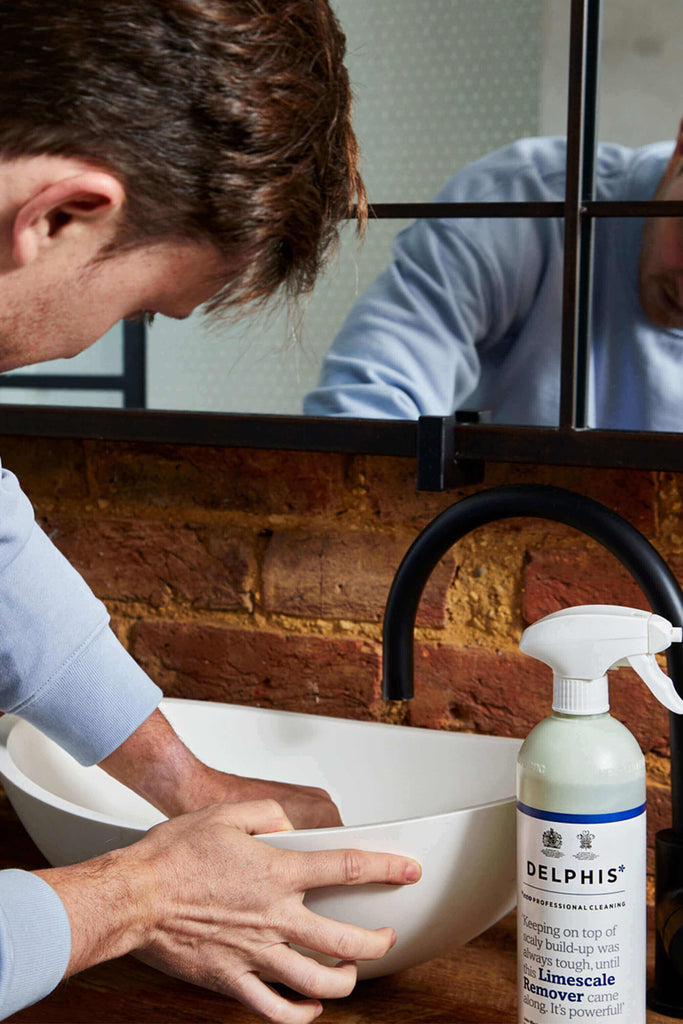How to remove limescale: effective ways to remove stubborn buildup

Limescale, that pesky white and chalky residue, can quickly turn your sparkling bathroom fixtures into an eyesore. Whether it's your toilet, bath, shower, or kettle, limescale buildup is a common challenge many homes and commercial spaces face.
In this guide, we'll explore the most effective methods to bid adieu to limescale and restore that shine. From learning how to remove limescale from toilets to tackling the thickest deposits, we've got you covered.
What is limescale?
Limescale, also known as calcium carbonate, forms when hard water evaporates, leaving behind mineral deposits. Over time, these deposits accumulate, resulting in the chalky, unsightly residue we all know too well.
Tools and ingredients you'll need, regardless of where your limescale issue is
For a DIY approach:
- White Vinegar: A natural acid that works wonders on limescale
- Lemon Juice: Another acid-based solution that's environmentally friendly
- Baking Soda: A versatile household ingredient with gentle abrasive properties
- Toothbrush or scrubbing pad: For gently scrubbing away deposits
For a straight from the bottle approach that’s super effective:
Choose from these options depending on where your limescale is.
Removing limescale from toilets
Toilets are notorious for limescale buildup, especially under the rim. Here's how to tackle it:
-
Vinegar Soak: Pour a generous amount of white vinegar into the toilet bowl, ensuring the limescale is submerged. Let it sit overnight. Scrub with a toilet brush and flush.
- Lemon Juice Paste: Create a paste with lemon juice and baking soda. Apply it to the limescale and let it sit for an hour. Scrub and flush.
Banishing Limescale from baths and showers
-
Vinegar Spray: Fill a spray bottle with equal parts water and white vinegar. Spray the affected areas and let it sit for about 30 minutes. Scrub and rinse.
- Baking Soda Scrub: Make a paste using baking soda and water. Apply it to the limescale, let it sit for 15 minutes, scrub, and rinse.
How to remove limescale from kettles in six easy steps
-
Fill your kettle halfway with equal parts water and white vinegar
-
Bring the mixture to a boil. As it boils, the vinegar's acid will break down the limescale deposits.
-
Turn off the kettle and let it sit for about an hour. If the limescale is particularly stubborn, you might want to leave it overnight.
-
Scrub and rinse - after the soaking period, use a soft cloth or a brush with soft bristles to gently scrub away the loosened limescale. Be careful not to scratch the kettle's interior. Rinse the kettle thoroughly with clean water multiple times to ensure there's no vinegar residue left behind.
- Fill the kettle with clean water and bring it to a boil
- Discard the water and repeat the boiling water rinse once more to remove any remaining traces of vinegar.
Your kettle should now be limescale-free and ready to brew your favourite drinks without any unwanted flavours or residues.
Dealing with Thick Limescale Deposits
Thicker deposits might require a bit more effort, but these methods can make a significant difference:
-
Vinegar Soak: Soak a cloth in vinegar and place it over the limescale. Let it sit for a few hours, scrub, and rinse
-
Commercial Limescale Removers: There are many commercial products specifically designed to tackle tough limescale, including our own version
-
Preventing Future Buildup: Prevention is the key to maintaining a limescale-free bathroom. Consider these tips:
-
Install a Water Softener: If hard water is a recurring issue, a water softener can greatly reduce limescale buildup
-
Regular Cleaning: Incorporate routine cleaning with mild acid-based solutions to prevent limescale from accumulating
- Squeegee Surfaces: After every shower, use a squeegee to remove excess water from surfaces, which will minimise mineral deposits
So there we have it, while limescale may be stubborn, armed with the right tools and knowledge you can easily restore the shine of your bathroom, toilet, tiles and surfaces. Consistent maintenance and preventive measures can go a long way towards keeping your bathroom fixtures limescale-free and sparkling.

Leave a comment